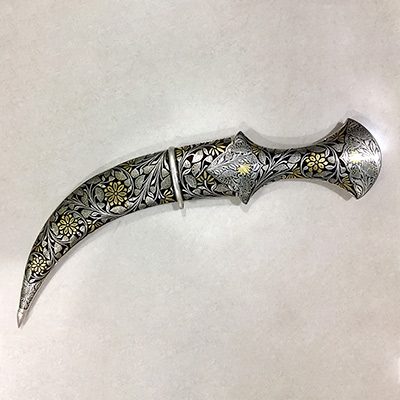Koftgiri Art - Rajasthan
The art of decorating arms and weaponry is known as Koftgiri. This art originated in India around 500-700 years ago with the Mughals. An age-old craft is practised in Mewar district. Nowadays it can be seen in Jaipur and Udaipur. Koftgiri refers to the action of ‘beating’ the pattern into iron. It can be both an inlay and overlay art. It is the art of ornamenting surfaces by inlaying light metal on a dark one using gold or silver wires. In Koftgiri, traditional motifs are made by inlaying a lot of lines and curves with gold or silver wires. Primarily these two metals are preferred due to their quality of flexibility. The entire design is created mainly by wire.
Traditionally, the Sikligar community has been practising this craft in Udaipur, Rajasthan. The Koftgiri work is done on objects made of iron metal like daggers, swords, shields, dagger heads, sticks, etc. Initially, this art was used in decorating handles of swords and daggers and hunting knives. Many years ago the traditional armourers of Rajasthan, Gadi-Lohars were widely use Koftgiri to create weaponry and armour for the use of their Rajputs, rulers and noblemen of the time. Earlier craftsmen were asked to use their creativity to decorate weaponry to impress rulers. The hunting excursion and the scenes of royal processions were the inspiration for them to embellish weapons. Gradually Kofigiri craft become more of a commercial rather than a usage-based craft.
During the Mughal times, Koftgiri artists were killed after finishing their creative work by rulers for not copying their handwork. They don’t want to lose their uniqueness. This created insecurity among artists. To protect the Koftgiri art and the artists' Rajput rulers started hiding Koftgiri artists under their patronage. Since then these artists practising Koftgiri by hiding themselves. Only a few families in Udaipur practice this unique art. One of them was Late. Shri. Rajesh Ghalot. He was practising Koftgiri since his childhood. After his sudden dismissal his wife Smt. Shyamlata Ghalot started practising this art. Both of them have been rewarded with many national and international awards.
To date sixteen Rajasthani handicrafts have been approved a GI (Geographical Indications) tag. Recently GI approved five more handicrafts to this list. They are Koftgiri Metal Craft of Udaipur, Nathdwara Pichhwai Craft of Rajsamand, Bandhej work of Jodhpur and Usta Art of Bikaner. For the first time, Udaipur art is labelled GI tag for Koftgiri Art totalling twenty-one types of arts and handicrafts of Rajasthan. This historical art is still preserved by the Maru Lohar community in Mewar district of Rajasthan. This will not only safeguard the traditional knowledge and cultural expressions of the State but also support the disappearing artwork.












